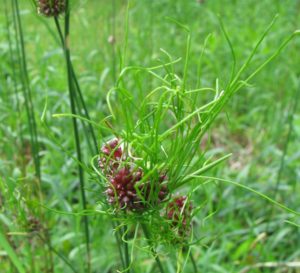The Middle of May Provides Dozens of Wild Delicacies

In case you didn’t know, the editor/publisher of this site is a forager of all sorts of wild foods. While mostly self-taught, I’ve learned from some local legends like Ron “The Hawk” Tomah, Oak Duke, and Buster “Leek” Larkin. Foraging is nearly a year-round pursuit which starts at the first thaw(mid-February) and often doesn’t end until Christmas when all the tree nuts have dropped. Even in the dead of winter, medicinal fungus hunters stalk the chaga mushroom which is easier to spot in a winter forest.
For most foragers, the prime season is right now, during the “greening”. Every degree that the ground temperature rises, a new feast presents itself, in a very predictable annual cycle. By the time we get to May, a real variety of forage and flavors have emerged. Leeks(ramps) and wild garlic are in a prime harvest window, stinging nettle is young and tender(but still dangerous hunting), the ostrich fern is producing fiddleheads, and the ultimate gourmet mushroom is being found all over Western New York: Morels.
That perfect mix off garlic, onion, and spring, what we call “leeks”. This member of the lily family is prolific on our hillslopes and also in the lowland meadows. Personally I don’t remember a time when I didn’t head out into the woods with a shovel, and my favorite beer to wash down that first spicy leek of the year. A young raw leek is tender and can pack some heat… think raw horseradish or wasabi. As they grow in size, they become milder in flavor and just before they ‘go to seed’ are ideal for pickling. By June 1st, most of the leeks have produced a short lived flower and both its texture and flavor are degraded.

Wild Garlic, who is a member of the allium family, is prolific on the banks of the Genesee River. When I discovered this grassy looking plant it was with my nose!! I suspect many trout fishermen over the centuries have had the same experience and used the little single bulb garlic for a spring feast. One of my favorite things about wild garlic is the flower, myself and a chef pal named them “Snargledaddies”!! They look pretty neat on a fancy meal!
The Stinging Nettle is so much more than a “prickerbush”!! Prized for its nutty flavor, nutrition, and even immune system boost: This plant has been part of our indiginous diet since long before recorded history. Today fine dining often features nettles and in Europe whole festivals revolving around eating raw nettles and guzzling beer to dull the painful rash(World Nettle Eating Championship). In America, we are largely more sophiscated with our nettle eating. In order to remove the stinging needles, eaters usually boil the nettles, and then sautee in butter. They are eaten like spinach as a side dish or in a soup. Some old world bakers will create a nettle bread!! When harvesting be ready to get itchy!!! The inevitable pricks can be itchy and annoying, like a mild case of poison ivy, but they provide a big immune system response. Many who suffer from auto-immune diseases swear by the benefits.

My dad told me stories about fiddleheads and this Native American pal of his who collected them every year for a big party at the Elks Club. “The Hawk”, Ron Tomah, a longtime Wellsville resident, was kind enough to pass down some generational knowledge to me many years ago. Once you start the hunt for fiddleheads you quickly realize that they cover the banks of the Genesee River. Without an exaggeration, tons of these ‘asparagus-like’ curled leaves of the ostrich fern are emerging as you read this. The ostrich fern is a pre-historic plant, so you are literally eating dna from the time of the dinosaurs. They cook pretty easy also: My suggestion is to clean well(can be sandy), bring to a rolling boil, and strain. After that they are great for the sautee pan with butter, salt, and usually vinegar. Fiddleheads also can be roasted, pureed for soup, and pickled to last the whole year!! Warning on fiddleheads: Only harvest and eat the ostrich fern, the lady fern is fuzzy and pithy, and the bracken fern can cause some digestive distress.
Right about now, or when the oak leaf is the size of a mouse’s ear, is the time to find the morel mushroom. Some chefs will tell you this is the best mushroom possible in terms of flavor and texture. Professional foragers sell these mushrooms for up to $50 per pound!!! Morel locations are protected from even family and best friends. They can be found in all sorts of ecosystems…. apple trees, dead elm trees, and in mixed forests. One of the most popular morel recipes is a braised morel in a cream sauce. Slowly finishing the mushrooms in sherry cream sauce is a meal accompaniment fit for royalty.

With such a variety of forage available, a true feast is coming to my table soon, maybe yours. Some of my favorites are steamed and sauteed leeks with lots of butter, wild garlic and nettle pesto pasta, and a course of plate full of morels in a wild garlic wine sauce!!





